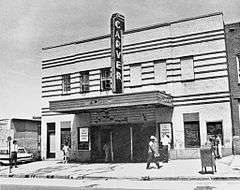John Jacob Zink
John Jacob Zink (1886-1952) was an American architect who designed movie houses in Washington, D.C., and Baltimore.
John Jacob Zink | |
|---|---|
| Born | June 1, 1886 Baltimore, Maryland[1] |
| Died | August 15, 1952 (aged 66) |
| Nationality | American |
| Alma mater | Maryland Institute, Columbia University |
| Occupation | Architect |
| Buildings | Uptown Theater, Newton Theater, Atlas Theater and Shops, Senator Theatre |
Life
He studied at the Maryland Institute (now known as Maryland Institute College of Art), and graduated in 1904.[1] He apprenticed with Wyatt and Nolting and William H. Hodges.[1] In the evenings he studied at the Columbia School of Architecture and worked with architect Thomas W. Lamb. He worked for Ewald G. Blanke, a famous Baltimore architect from 1916-1924. Their firm of Blanke and Zinc was located at 835 Equitable Building in Baltimore City.
In the early 1920s, he started his own design firm. He was a Streamline Moderne architect. Employing modest designs, he concentrated on details, such as views, lighting and acoustics. He incorporated such amenities as nurseries, lounges and smoking rooms.[2]
Works

- 1936 Uptown Theater
- 1937 Newton Theater
- 1938 Atlas Theater and Shops
- 1939 Senator Theatre, Baltimore
- 1939 Congress Theater
- 1940 Apex Theater
- 1940 Village Theater
- 1942 Senator Theater, Washington, D.C.
- 1945 Langston Theater
- 1945 Commodore Theater, Portsmouth, Virginia[5]
- 1946 Naylor Theater [6]
- 1948 Carver Theater, Anacostia, Washington, D.C.[7]
- circa late 1940s Capital Theatre, Annapolis, MD[8]
- 1950 Flower Theatre, Silver Spring, Maryland[9][10]
- 1952 Langley Theatre, Langley Park, Maryland [11]
References
- "Zink, John Jacob (1886 - 1952)". Philadelphia Architects and Buildings. 2019. Retrieved 2019-01-03.
- "Capitol Theatre". Crispin Enterprises. Archived from the original on 2012-03-31. Retrieved 2012-03-31.
- Takoma Theatre Conservancy - Theatre Building Archived 2011-07-28 at the Wayback Machine
- Takoma Theatre in Washington, DC - Cinema Treasures
- History by the Commodore Theatre - Portsmouth, VA
- Naylor Theatre in Washington, DC - Cinema Treasures
- "Carver Theatre". Anacostia. Cinema Treasures. Retrieved 21 April 2012.
- http://cinematreasures.org/theaters/22650
- Flower Theatre in Silver Spring, MD - Cinema Treasures
- Inside Movies Since 1920
- Langley Theatre in Langley Park, MD - Cinema Treasures
External links
- "John J. Zink". Cinema Treasures.
- "John J. Zink, Architect". Takoma Theater. Takoma Theatre Conservancy. Archived from the original on 2011-07-28. Retrieved 2011-07-28.